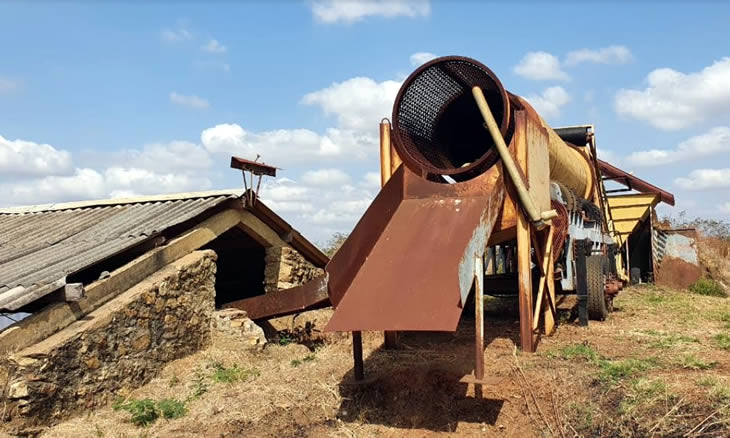TotalEnergies tells Mozambique LNG project costs have risen by $4.5 billion - Reuters
Mozambique: Gold plunder in Niassa assumes industrial proportions – O País

Photo: O País
A few days ago, the Ministry of Mineral Resources and Energy (MIREME) received a complaint of two companies illegally mining gold in the village of Ntulo, near the town of Lupilichi in Cóbuè administrative post, Lago district, Niassa province.
An inspection team led by the MIREME inspector general Obede Matine was immediately created to investigate the complaints. An ‘O País’ reporting team was invited to join the group. We left Lichinga at 6:00 a.m., with 110 km of paved road and another 200 km of dirt road ahead of us.
Seven hours later, we arrived at the site, and the scene of intensive open pit mining activity, with huge open craters from which the inspection team surmised that ore had been removed to extract the gold.
The inspection team started by establishing the geographic coordinates of the place, to find out if the area coincided with what they had in their files. The conclusion was that the area under exploitation was not licensed for research and prospecting, much less for exploitation, which meant that theft of resources on an industrial scale was taking place.
The inspectorate says that looting on an industrial scale is being carried out by a public limited company called Focus 7 Exploration, which holds a license to prospect for gold, diamonds and other resources, under number 9615L, issued in 2018 and lasting five years, that is, until 2023, in an area close to the one where the gold is being mined. But there is no authorisation to exploit resources, as is in fact happening on the ground, and at industrial levels.
In fact, the team found excavator shovels in full action and at least six dump trucks ready to load the excavated material. Despite the fact that the operations were illegal, there was protection on site in the person of a Republic of Mozambique police officer, armed and in possession of a communication system.
Inspector Obede Matine tried to speak with the person in charge of the operations, but the man, ostensibly of Chinese nationality, pretended not to understand Portuguese,. Even so, the inspector insisted that he accompany him to the mining area. He accepted, but changed his mind on the way and left, claiming that he was not available.
At the work site were also found six men who said that they were recruited in Cabo Delgado to work at the mine, but had no contracts and did not know what they were going to do, nor how much were they going to be paid. They had been at the site for two days, but did not know what they were going to do there.
From the mine, we left for another area, close to the river, just over 10 km away, where the trucks were taking the excavated material for processing. Arriving there, we found a huge gold processing installation with capacity to process over 700 cubic metres of ore per day.
There were also another two machines, each with a capacity of 70 cubic metres per day, which were inoperative, but showing of being used in gold processing operations in the not-too-distant past.
The person in charge there said his name is Alex Lau, also supposedly a Chinese national. He confirmed that the two machines had been processing gold since last April but were now stood down for maintenance.
Mr Lau said he did not know how much gold had been mined, nor the name of the company and its owners, despite being in charge of the huge processing plant.
The area where the processing plant is located was the subject of an unsuccessful 2016 request from the company Niassa Oro Mining for research and prospecting for gold, mineral coal and other resources.
According to Inspector General Matine, we were face-to-face with illegal exploitation of gold, with no license or other authorisation for the purpose, and the government having no notification of the operations or information as to how much gold had been removed from the area.
According to Matine, research and prospecting licenses permit industrial production tests, but this must be authorised and monitored by the authorities to determine the size and processing capacity, the quantity of the ore excavated and the quantity of gold extracted, among other important information. But that did not happen with the companies in question.
Another major concern expressed by the MIREME inspector is that the companies are operating without any environmental management plan aimed at recovering areas degraded by the activity, and without any water treatment systems in use in the processing.
This Monday, inspector Matine summoned the top leadership of the companies to a meeting at the Directorate of Provincial Services for Infrastructures, for explanations and possible action against mineral resource infractions.
In Lupilichi, a good example of gold exploration
After working at both companies, the MIREME brigade travelled almost 50 kilometres towards the border with Tanzania, to a region called Mpapa inhabited by people whose main activity is gold mining. The community discovered gold in 1992, when the area was invaded by Tanzanian miners who had left their country in pursuit of it.
At the time, the community reported the existence of gold to the then Provincial Directorate of Mineral Resources and Energy, which started to assist them. From there, four associations of artisanal miners emerged throughout the Lupilichi region, and in Mpapa, the 1º de Maio Association operates with 11 members.
They work an extensive underground mine with 20 shafts up to 70 metres deep and galleries 20 metres long, capable of holding three to five miners at a time. There, they extract the rock that is broken up on the surface by local workers, then crushed in machines. The powder that comes out of it is then washed to separate the gold.
More than 650 people aged from 18 to 40 work in the mine. No-one can say exactly how much gold is mined there. The association says about 15 to 17 grams per month, but government officials talk of 30 kilograms being extracted in Lupiliche in the first half of this year alone. The gold is sold to a company called Bright Gold, subcontracted by the Empresa Moçambicana de Exploração Mineira, but it is also sold illegally to Tanzanian buyers. This may be because Bright buys pay 2,000 meticais per gram, while the Tanzanians pay much more.
In fact, it is difficult to establish the actual amount of gold produced because of attempts to evade the tax authorities. But the positive side is that the associations have full control over gold mining, despite using rudimentary and inefficient extraction systems.
On the other hand, these same associations do not observe the rules of hygiene and safety at work, and neither do they have in place a clear environmental management system. The work is practically slavery, because there is no protective equipment and remuneration is an unclear manner. Very few have a monthly salary and most of them are paid for the amount of stone bags they extract or the amount of stone they break or, finally, the amount of gold allegedly extracted. If a worker brings ten bags of stone to the surface and no gold is found, they don’t get paid.
Meanwhile, in the middle of mountains and out of nowhere a city has emerged. There are practically no houses of precarious construction there, and the association itself functions as a local government, providing free water to the community and with a generator that supplies electricity to all households, with each family paying between 100 to 200 meticais per week depending on the appliances they use.
The four associations in Lupiliche have come together to build five schools and regularly maintain the road that runs from Cóbuè to the town’s headquarters.
After meeting the miners, the MIREME inspector was convinced that it was urgent that his ministry help the association can improve the methods it uses to extract gold.
This is because a cooperative, or a company, can be authorised to use sophisticated machinery, explosives and other means that can help it increase the recovery of the extracted material and its purification.
Currently, the gold explored by the association has a purity level of 92 to 93%. If processed using more advanced techniques a purity of 97 to 98% can be reached, raising its value.
From Lupilichi, we left for Mavago to visit another association that mines rubies in the Niassa Reserve buffer zone. We were unable to reach the site due to the poor road conditions and safety concerns, with only the inspector and some technicians going on. They say they found artisanal exploration being conducted by an association of former combatants. In the past, they had joined a company also made up of former combatants, who had in turn subcontracted the Chinese company Sogecoa to mine the rubies, but after six months there were disagreements and the deal was broken up.
The team also went to Cuamba district, to visit the company ‘Sociedade Vision 2000’, which has a license to mine garnet, a precious stone. It has however not been operating since 2013, because the activity proved no longer profitable. The company carried out a study that found garnets in large quantities, but requiring processing technology it could not afford. It is currently negotiating a partnership with Chinese investors.
Since activities came a standstill, the area has been invaded by illegal miners who extract the garnets and sell them to precious stone agents, some of whom are unlicensed. We talked to some prospectors who said they got 15 meticais per gram, while Vision, when it still operated, paid them US$90.
Artisanal miners have asked the government to authorise Vision to buy the stones they extract from, while Inspector Matine has in the meantime warned the company that it must resume activities or risk losing its license for having ceased activity for more than five years.
By Francisco Mandlate












Leave a Reply
Be the First to Comment!
You must be logged in to post a comment.
You must be logged in to post a comment.